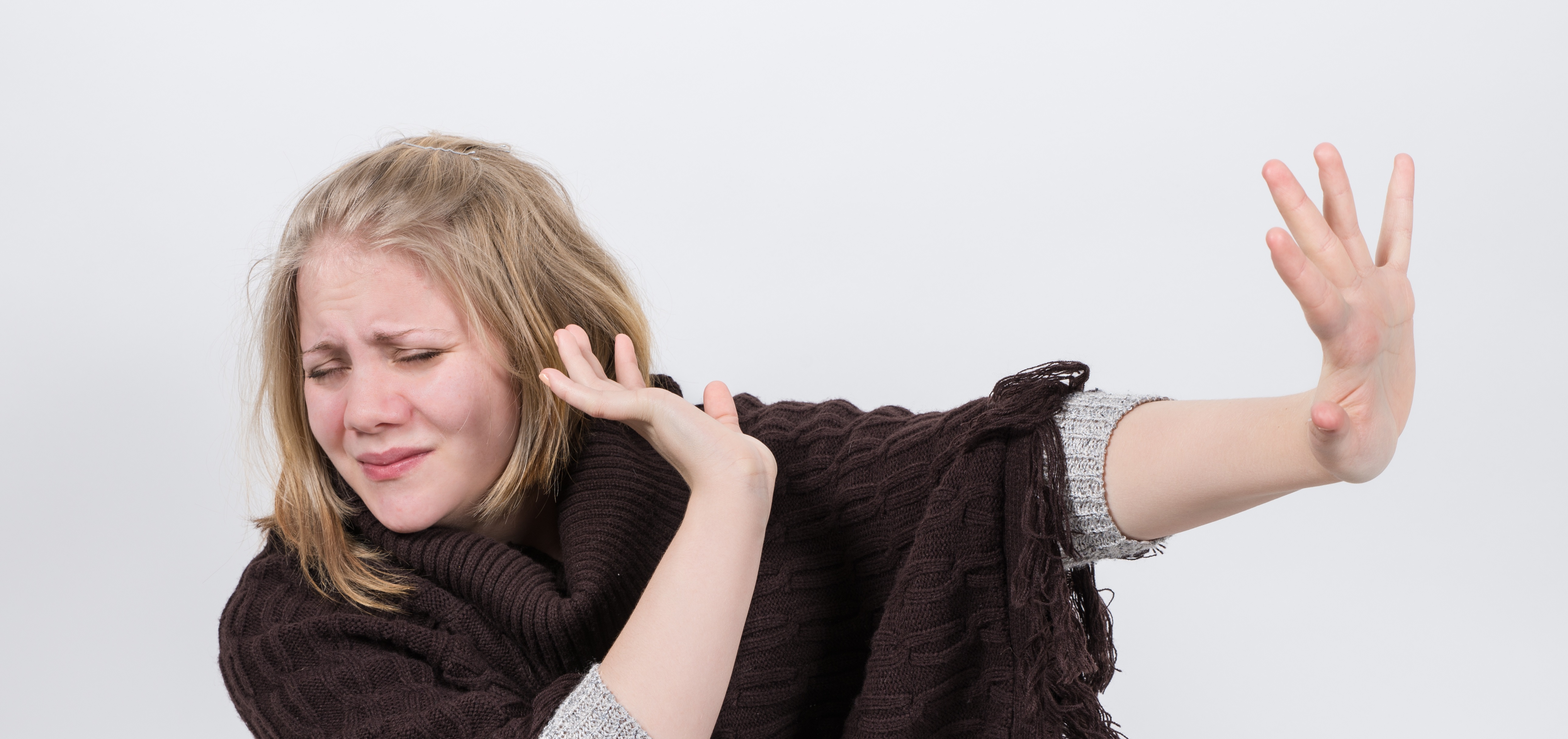General signs and symptoms
This category provides information about the general signs and symptoms of PTSD. Common PTSD symptoms include unwanted and upsetting memories, nightmares, flashbacks, emotional distress and physical reactivity after exposure to reminders, which leads to avoidance of these reminders. There may also be symptoms of poor sleep, negative thoughts and mood, depression, anxiety, dissociation, and anger. There may also be problems with cognition, such as memory, attention, executive functioning, general cognition, social cognition, and difficulty processing new information. Click on the links or the tabs below to access all the information, or browse and search via the drop-down menu on the left.
Image: tashatuvango – stock.adobe.com

Anger and aggression
Is anger and aggression common in PTSD? Excessive anger is often observed in people with PTSD and other anxiety-related disorders. In PTSD, a propensity towards excessive anger may be apparent before exposure to a trauma, for example as a personality trait. Or it could be a result of exposure to the trauma itself and a symptom of PTSD. Elevated anger in people with PTSD has clinical implications as it may be a barrier to effective treatment outcomes. Therefore, anger and aggression are key targets for improvement early in the treatment process. What is the evidence for anger and aggression in…

Anxiety
How are anxiety symptoms related to PTSD? Many people with PTSD experience worrying, fear, and sleep problems. These may disrupt daily functioning, but may not meet the criteria for an anxiety disorder. They may be associated directly with the trauma itself, such as being diagnosed with a physical illness or being exposed to forced displacement or war. They may also be aggravated by other, core symptoms of PTSD, including emotional distress, physical reactivity after exposure to reminders, and upsetting memories, nightmares, and flashbacks. This topic concentrates on the presence and severity of subclinical anxiety symptoms in people with PTSD. Please also see…

Avoidance
What are avoidance symptoms in PTSD? Avoidance is a core symptom of PTSD, with at least one avoidance symptom required for a diagnosis. People often try to cope with the trauma by avoiding distressing memories, thoughts, or feelings associated with the event. This may be effective in the short-term, but in the long term it may be associated with poorer outcomes. What is the evidence for avoidance symptoms in people with PTSD? Moderate to low quality evidence finds three clusters of avoidance symptoms. These are avoidance of thoughts and feelings, avoidance of activity, and avoidance of memory. Avoidance of thoughts/feelings;…

Depression
What are depression symptoms in PTSD? Depression symptoms are common in people with PTSD. It is characterised by a depressed mood and a loss of interest or pleasure in activities. Symptoms of depression can also include changes in appetite, weight, sleep, or psychomotor activity, decreased energy, feelings of worthlessness or guilt, difficulty concentrating or making decisions, and thoughts of death or suicide. Depression may also be associated with increased hopelessness, which is the absence of positive future orientation. This topic concentrates on the occurrence of depressive symptoms rather than depressive disorders in PTSD. Please see the co-occurring mental disorders topic…

Dissociation
What are dissociation symptoms in PTSD? Dissociation is a disruption in the normal integration of consciousness, memory, identity, emotion, perception, body representation, motor control, or behaviour. Common dissociative experiences include mild forms of absorption, such as daydreaming. Less common and more severe dissociative experiences include amnesia, derealisation, depersonalisation, and fragmentation of identity. Dissociation is not required for a diagnosis of PTSD. Trait dissociation is a stable characteristic that may be a vulnerability factor for PTSD. In contrast, state dissociation occurs in response to situations. Peritraumatic dissociation is a form of state dissociation and refers to dissociation that occurs during a…

Distress
What are distress symptoms in PTSD? Traumatic distress consists of negative emotions experienced during or shortly after a traumatic event. Responses of fear, helplessness, and horror represent a subset of distress reactions that currently define trauma exposure in the Diagnostic and Statistical Manual of Mental Disorders (DSM–5), along with life threat. It is unclear if traumatic distress affects the development or persistence of core symptoms across time. Core PTSD symptoms include intrusions, avoidance, hyperarousal, and negative thoughts and mood. What is the evidence for distress in people with PTSD? Moderate to high quality evidence found increased severity of PTSD symptoms was…

Hyperarousal
What are hyperarousal symptoms in PTSD? Hyperarousal is a core symptom of PTSD, with at least two hyperarousal symptoms being required for a diagnosis. Hyperarousal symptoms include irritability or aggression, risky or destructive behaviour, hypervigilance, heightened startle reaction, difficulty concentrating, and difficulty sleeping. What is the evidence regarding hyperarousal in people with PTSD? Moderate to high quality evidence finds small effects of less sleep efficiency, less total sleep time, less slow wave sleep, and more wake time after sleep onset in people with PTSD. Moderate to low quality evidence finds a medium-sized effect that people with PTSD and sleep disturbances…

Intrusions
What are intrusion symptoms in PTSD? Intrusions are core symptoms of PTSD, with at least one intrusion symptom being required for a diagnosis. Intrusion symptoms include unwanted and upsetting memories, nightmares, flashbacks, and emotional distress and/or physical reactivity after exposure to reminders. What is the evidence for intrusions in people with PTSD? Moderate to low quality evidence finds five clusters of intrusion symptoms; distressing memories, distressing dreams, flashbacks, emotional cue distress, and physiological cue reactivity. Items relating to distressing memories Disturbing memories kept coming into my mind. I found myself remembering bad things that happened to me. Upsetting thoughts kept…

Negative thoughts and mood
What are negative thoughts and mood in PTSD? For a diagnosis of PTSD, there needs to be at least two “negative alterations in cognitions and mood”. These include negative thoughts or feelings that began or worsened after the trauma, an inability to recall key features of the trauma, overly negative thoughts and assumptions about oneself or the world, exaggerated blame of self or others for causing the trauma, negative affect (e.g., fear, horror, anger, guilt, or shame), decreased interest in activities, feeling isolated, and difficulty experiencing positive affect. What is the evidence for negative thoughts and mood in PTSD? Moderate…

Perceptions of defeat and entrapment
How are perceptions of defeat and entrapment related to PTSD? Perceived defeat involves a perception of powerlessness from the loss or significant disruption of social status, identity, or hierarchical goals. A failure to attain, or loss of, valued social and material resources may induce perceptions of defeat. Social put-downs or attacks from others, and internal perceptions of self-criticism, worthlessness, and incompetence can also induce perceptions of defeat. Perceived entrapment occurs when the usual motivation to escape threat or stress is blocked. This could be due to no or low likelihood of individual agency or rescue by others. Having a difficult…

Personality and temperament
How are personality and temperament related to PTSD? Personality and temperament are thought to be relatively stable over time. A maladaptive combination of personality and temperament traits may constitute a risk factor for the development of psychological dysfunctions. Temperament traits are considered one of the most important moderators of the relationship between stress and psychopathology. What is the evidence regarding personality and temperament in people with PTSD? Moderate to high quality evidence found small relationships between increased PTSD symptoms and increased emotional reactivity and perseveration. There were also small relationships between increased PTSD symptoms and decreased traits of endurance, briskness,…
Green - Topic summary is available.
Orange - Topic summary is being compiled.
Red - Topic summary has no current systematic review available.
